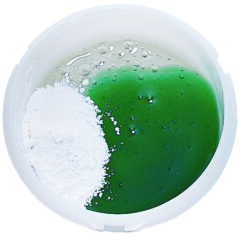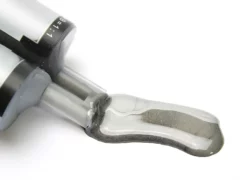Air bubbles: enemies of dispensing.
When it comes to bonding with epoxy resin, precise dosage plays a decisive role. A poor ratio between components or insufficient mixing can cause air bubbles flaws that affect both aesthetics and performance. Fortunately, several effective methods exist to minimize or even eliminate these imperfections. We’ll review best practices for preventing and removing air bubbles, and highlight the role of mixing equipment, particularly THINKY’s planetary mixers.
Why are air bubbles a problem, especially in epoxy?


Air bubbles in epoxy resins can lead to several industrial issues:
• Aesthetic defects: bubbles create visual flaws on finished surfaces.
• Reduced mechanical strength: they weaken the resin’s structure.
• Impaired adhesion: bubbles can disrupt bonding between surfaces.
• Finishing challenges: air pockets complicate techniques like polishing.
• Unpredictable curing: bubbles can alter cure times and chemical reaction rates.
• Increased costs: defects may require rework, extending production time.
Because of these risks, mastering the mixing process and using the right equipment is essential to avoid air bubble formation in epoxy.
Operation of a planetary mixer

In a planetary mixer, the mixing arms rotate around a central axis while also rotating on their own. This combined motion reaches every part of the mixture, ensuring a uniform distribution of fluids.
The planetary mixer is an essential tool for achieving high-quality mixes, especially in applications where precision and homogeneity are crucial. Its unique operation reduces dosing errors and prevents the formation of air bubbles, two critical factors for successful projects using epoxy resins. It allows efficient mixing of substances with different viscosities.
Most planetary mixers are equipped with variable speed settings, enabling the user to adapt mixing to the nature of the materials. Higher speeds can be used for liquid mixtures, while lower speeds are often preferable for denser materials.
Manual mixing vs automatic mixers
Manual mixing may be sufficient for small quantities, but it has limitations:
- Physical effort: hand mixing is labor-intensive, especially for large volumes.
- Inconsistency: uneven mixing often introduces air bubbles.
Automatic mixers like THINKY’s planetary systems offer:
- Homogeneous mixing: consistent, bubble-minimizing results.
- Time savings: much faster mixing, even for larger batches.
| Functions | Benefits |
| Dual planetary motion | Fast and uniform mixing |
| No blades | No mechanical cleaning required |
| Mixing in the final container | Zero cross-contamination |
| Vacuum compatible | Complete elimination of bubbles |
| Digital programming | Guaranteed repeatability |

Importance of respecting mixing ratios
Respecting mixing ratios is crucial when working with epoxy adhesives and other similar materials. Precise dosing not only ensures the quality of the final product but also influences several aspects of the mixing process and the material’s performance.
Proper mixing of the components in an epoxy resin ensures that the final product’s mechanical properties such as tensile strength, hardness, and toughness reach optimal levels. If the ratio is not respected, the product may become too brittle or not rigid enough.
Epoxy resins are often composed of two parts: the resin and the hardener. Each part must be mixed in the correct ratio to achieve complete and uniform curing. Incorrect dosing can result in partial curing, leaving soft or sticky areas in the product.
Respecting the mixing ratio also helps control the solution’s viscosity, reducing air bubble formation. An incorrect proportion may make the resin too fluid or too thick, trapping air and leading to aesthetic and structural defects.
Some chemical reactions between epoxy resin components can be exothermic. An inaccurate dosage can make these reactions unpredictable, increasing the risk of accidents. Therefore, respecting ratios is also essential for ensuring safety during mixing and application.
Use of a vacuum pump
A vacuum pump is used to create a low-pressure environment inside a container holding the mixed epoxy adhesive. This process removes air bubbles that naturally form during mixing, providing an effective solution to minimize visual and structural defects in the final product.
- Vacuum creation: when a vacuum pump is activated, it reduces the pressure inside the container, allowing trapped air to expand and burst.
- Degassing process: this results in rapid degassing of the resin, where air bubbles rise to the surface and are eliminated before the resin cures. By avoiding air bubbles, the finished surface of the resin is smoother and more attractive, without visual imperfections.
- Consistency: the use of a vacuum pump helps maintain consistent mixes, ensuring that each batch has the same performance characteristics.
Examples of applications where mixing is crucial
- Composite materials / Composite part manufacturing: in the aerospace and automotive industries, mixing resins and reinforcements (such as glass or carbon fibers) must be precise to ensure the strength and lightness of the parts.
- Marine applications: composite components used in boat construction or marine equipment require optimal mixing to ensure durability and water resistance.
- Chemical industry / Paint and coating manufacturing: homogeneous mixing of pigments, resins, and additives is crucial to guarantee uniform color and durable adhesion to surfaces.
- Pharmaceutical products: in drug manufacturing, the mixing of active ingredients and excipients must be performed with precision to ensure product effectiveness and safety.
- Electronics / Printed circuit board assembly: solder pastes, which are a mixture of metal particles and flux, must be precisely mixed to ensure good conductivity and reliable connections.
- Component encapsulation: resin mixing for encapsulating circuits must be uniform to avoid air bubbles that could compromise electronic component performance.
- Cosmetics / Cosmetic manufacturing: mixing active ingredients, preservatives, and bases must be homogeneous to guarantee the safety and effectiveness of beauty products.
Discover how we supported one of our aerospace clients in mixing and packaging their epoxy adhesive loaded with silver particles.

By integrating these practices and knowledge into your projects, you will be able to maximize efficiency, reduce costs, and ensure safety in your epoxy resin applications.

